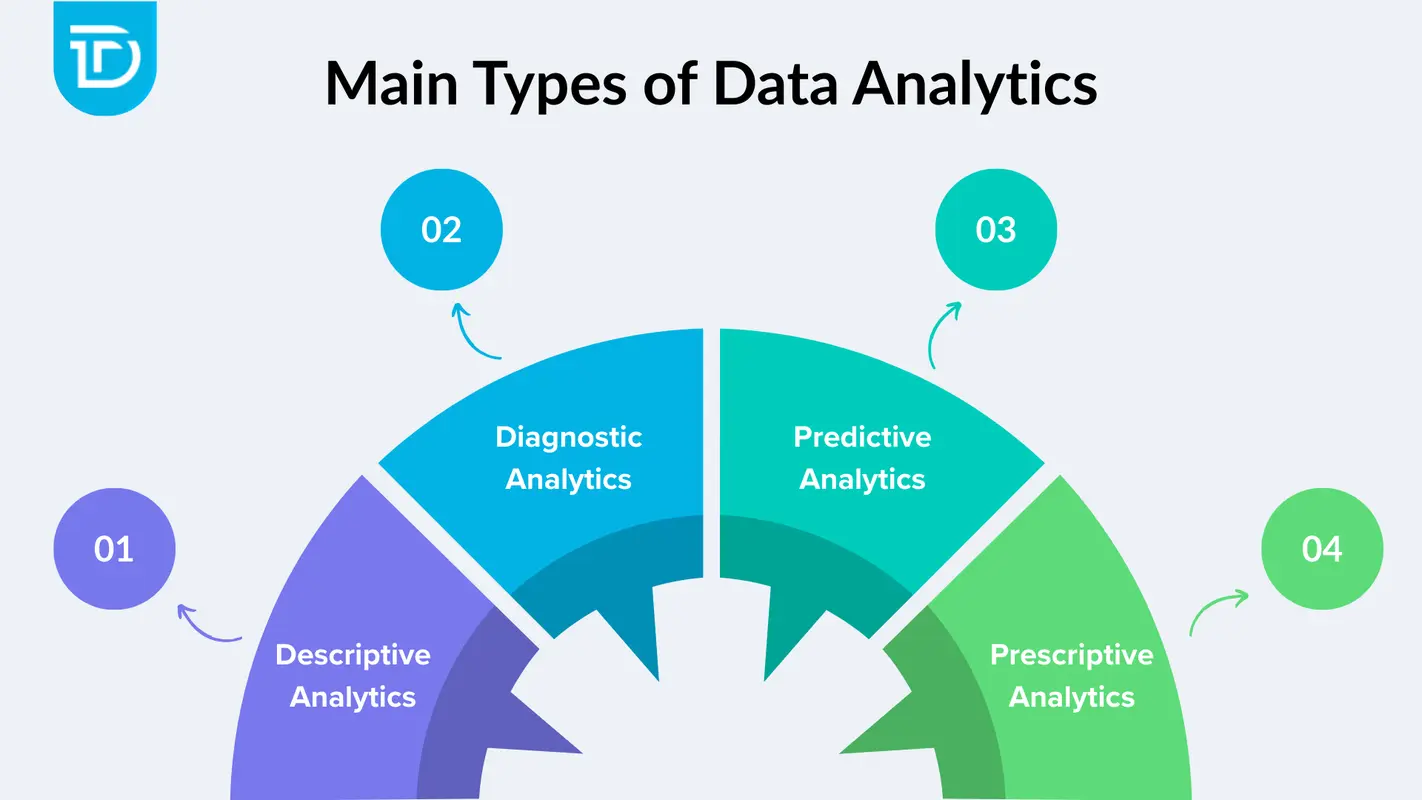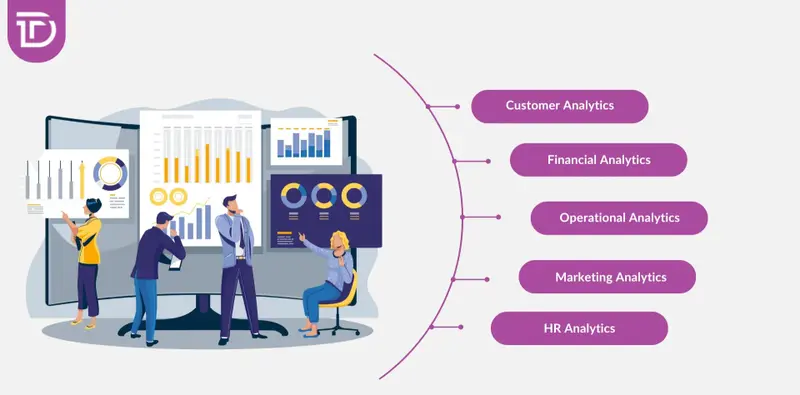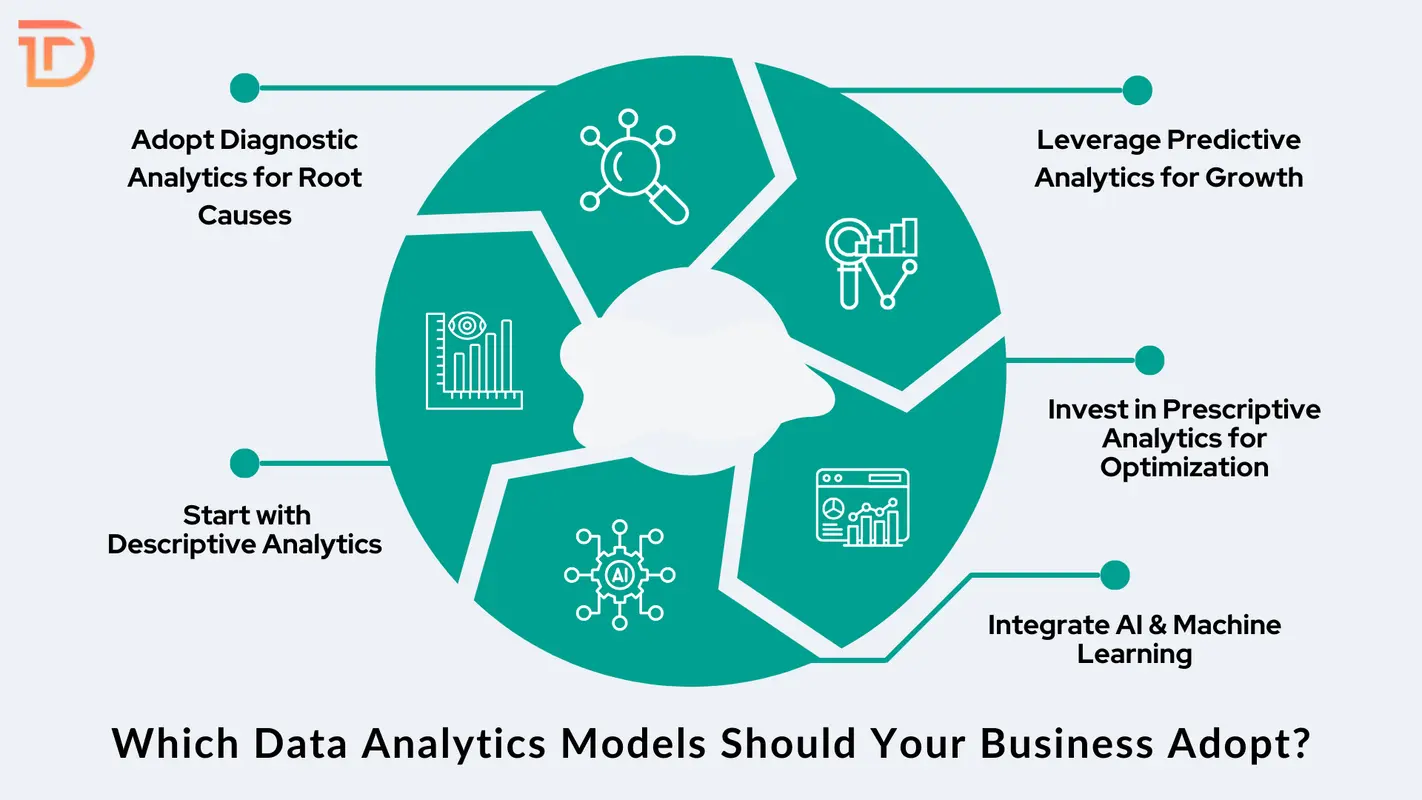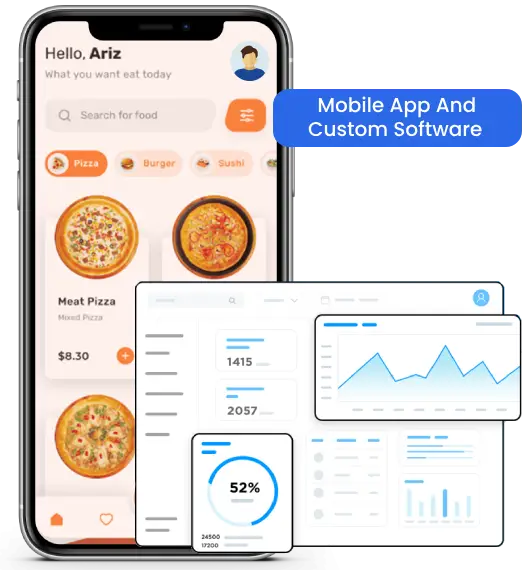Data is emerging as a powerful tool that is shaping how businesses make decisions, understand their customer base and market trends, and craft their strategies. But data alone isn’t useful until it’s analyzed! This is where data analytics comes into the picture. Data analytics is the process through which an organization turns raw numbers into actual strategic insights to help it better comprehend the current market, its targeted customers, and future trends, and thus make informed decisions. In this blog, we’ll uncover different types of data analytics, common forms of data analytics used by organizations, how AI is used in data analytics, and which data analytics model your business should adopt.
What are the Main Types of Data Analytics?
There are different types of data analytics, each playing a crucial role in showing how data drives decisions. From the simplest to the most complex, the four fundamental types of data analytics we are breaking down for you are:

Descriptive Analytics
Descriptive analytics primarily helps organizations understand “What happened?” By using techniques like data aggregation, statistical measures, and data visualization, descriptive analytics highlights what happened in the past and what’s happening currently, through which you can get an account of events.
Descriptive analysis serves as a basic form of analytics and as a foundation for deeper analysis. Examples of descriptive analysis include traffic and engagement reports, financial statement analysis, survey reports, and customer behavior summaries.
Diagnostic Analytics
Diagnostic analytics goes one step further than descriptive analytics by answering the question “Why did it happen?” It basically serves as a link between “What happened?” (descriptive analytics) and “What will happen?” (predictive analytics). Diagnostic analytics uses techniques such as data discovery, drill down, data mining, and correlation analysis.
The key feature of diagnostic analytics is to help organizations pinpoint the fundamental reasons for a particular problem or an event. Examples of where diagnostic analytics is used are sales decline in businesses, marketing campaign performance, financial discrepancies, or production bottlenecks.
Predictive Analytics
Predictive analytics addresses the question, “What is likely to happen in the future?” It uses techniques such as regression learning, decision trees, neural networks, ensemble models, and time series forecasting.
Predictive analytics helps organizations make informed decisions by anticipating future trends and outcomes. It supports risk management by predicting the upcoming risks, optimizes processes and resource allocation, enables personalized customer experiences, and uncovers new market opportunities.
Prescriptive Analytics
Prescriptive analytics is the fourth type of analytics that goes beyond predictive analytics and answers the most complex question: “What should we do about it?” It suggests specific strategies and what their potential implications can be. It uses techniques such as optimization algorithms, simulation models, decision trees, and machine learning.
Through prescriptive analytics, organizations can weigh several scenarios and understand the results of different decisions. Some of the common examples where prescriptive analytics can be used are airlines, healthcare, manufacturing, and supply chains.
Common Forms of Data Analytics Used by Organizations
The four main types of data analytics we have discussed above are the most common types used by organizations. It primarily depends on what their goals are, what resources they have, and what industry they belong to. Below we will understand the most common forms of analytics applications in different organizations:

Customer Analytics
For businesses providing services such as retail and e-commerce, understanding customer behavior and their preferences is the main priority. They typically use the four types of analytics for providing personalized recommendations and improving customer retention.
Financial Analytics
Many organizations use financial data visualization to gain financial insights and thus improve their budgeting and forecasting while enhancing their overall operational efficiency. It helps in risk management, fraud detection, and overall cost reduction.
Operational Analytics—
For gaining real-time insights and making faster, more informed decisions, the organization uses operational analytics. With operational analytics, organizations can get immediate, actionable data so that businesses can quickly respond to the changing market conditions and fix issues accordingly.
Marketing Analytics
With market analytics, organizations can measure their campaign performance. It helps businesses to refine their campaigns and make data-driven decisions instead of simply relying on assumptions.
HR Analytics
HR Analytics leverages data to enhance how organizations manage their workforce. Human resources employ people skills, but instead of simply relying on intuition, HR analytics gathers insights from employees, processes, and organizational outcomes to make better decisions. Through this, it can optimize recruitment in a better way and align talent strategies accordingly.
How Is AI Used in Data Analytics?
The primary function of data analytics is analyzing datasets so that it can identify patterns, trends, and correlations. However, when data becomes much bigger and more complex, AI comes in handy. AI in data analytics can process massive datasets at a much faster rate, uncover crucial hidden patterns, automate tedious repetitive tasks, and generate actual real insights for better decision-making. Here’s how AI enhances data analysis:
- To Handle Big Data: AI can process information at a much quicker rate and more efficiently compared to manual methods.
- Real-time Decision-Making: Certain industries, such as e-commerce or finance, have to deal with constantly changing market conditions. AI can prove to be immensely helpful in such scenarios by enabling real-time decisions.
- Anomaly Detection: Unusual patterns are typically hard to detect. This is where AI comes to the rescue! It can effectively detect frauds and system malfunctions and effectively pinpoint data inconsistencies.
- Workflow Automations: Through AI, companies can automate repetitive and time-consuming tasks. They can immensely help with data preparation, cleansing, and reporting. It provides free time for human analysts for more strategic work.
- Text and Natural Language Processing: AI, when used in data analytics, can help you gain valuable insights from large unstructured data, for instance, customer reviews, support tickets, and social media posts, to improve overall products and service.
- Predictive and Prescriptive Analytics: AI analyzes historical data to understand future outcomes and trends (which comes under predictive analytics) and suggests actions to optimize such outcomes (prescriptive analytics).
Which Data Analytics Models Should Your Business Adopt?
Though there are four different types of data analytics discussed above, businesses should adopt a layered approach to it. Starting with descriptive analytics and progressing to the final stage of prescriptive analytics. Here’s how you should start:

Start with Descriptive Analytics
If your organization is new to data analytics, begin with descriptive analytics. This provides a baseline understanding of past performance. Organizations can use it to create dashboards and regular reports. Through this, organizations can track key performance indicators (KPIs) and identify trends accordingly.
Adopt Diagnostic Analytics for Root Causes
Once you understand what has happened, use diagnostic analytics to uncover why those trends occurred. Through diagnostic analytics, you can understand the root causes of your past successes and the main reasons you are experiencing a sudden dip in sales. This will help refine strategies and avoid repeating mistakes.
Leverage Predictive Analytics for Growth
Organizations ready to scale should consider predictive analytics. Although no method or any amount of professional experience can predict future behaviors and trends with certainty, predictive analytics uses advanced algorithms and technologies that can come close to predicting things correctly. For instance, the retail industry can predict customer demand accurately to manage their inventory.
Invest in Prescriptive Analytics for Optimization
Businesses with advanced data systems and resources can implement prescriptive analytics. Through prescriptive analytics, organizations can best describe “what-if” scenarios and provide real-time recommendations for various types of goals, from maximizing revenue to enhancing customer satisfaction. For instance, businesses can personalize their marketing and can make fraud detection better.
Integrate AI & Machine Learning
By implementing AI and machine learning in data analytics, companies can gain deeper insights, resulting in much better-informed decisions. With the help of AI, businesses can save time by preventing repetitive tasks by automating them, detecting hidden patterns and complex relationships in datasets, and enhancing the overall speed and efficiency of various processes.
For a better approach, businesses can hire data visualization consulting services that can help break down large, complex datasets into more comprehensible ones and enable a smarter decision-making process.
Conclusion
Data analytics is no longer a competitive advantage for organizations now—it has become a necessity to get the best out of their large datasets and thrive in today’s fast-paced, data-driven world. The main four types of analytics explained in this blog are descriptive analytics to help organizations understand “What happened?”, diagnostic analytics for understanding “Why did it happen?”, predictive analytics for understanding “What is likely to happen in the future?”, and prescriptive analytics for understanding “What should we do about it?” If you are wondering which data analytics would remain most suitable for your organization, we recommend you use a start-to-finish layered approach to all types of analytics to optimize their strategies and gain a competitive edge over competitors.
Dreamer Technoland is a leading data visualization consulting services provider that excels in making organizations harness the power of data analytics. We ensure to incorporate AI to deliver results that are future-ready and intelligent solutions. We ensure to act as your partner from start to finish of the data analytics journey to transform raw data into actionable insights. This helps organizations to make informed decisions and achieve sustainable growth. Powered by our robust team of professionals, we ensure that by partnering with us, you remain ahead of the competition and can explore new opportunities.







